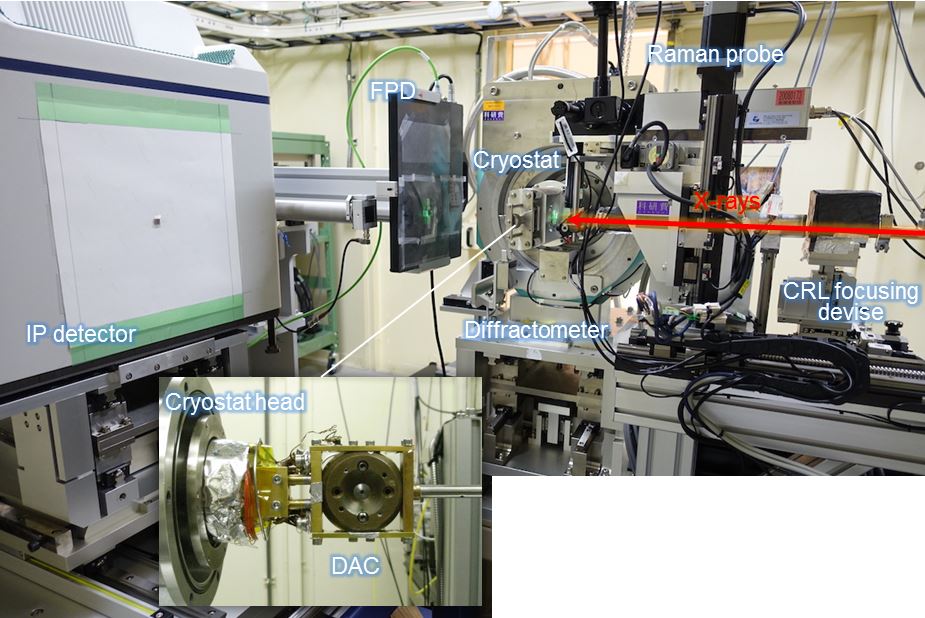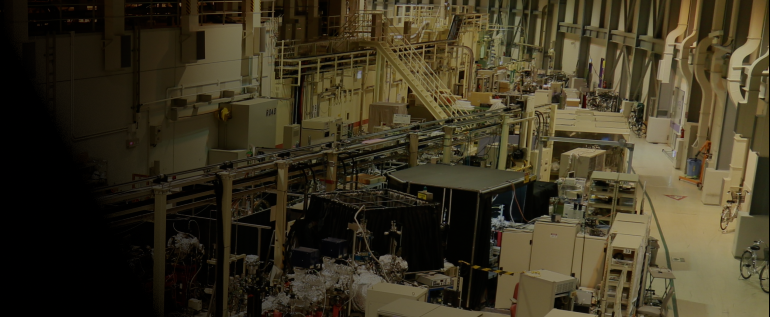低温高圧X線回折装置
◆装置概要
本システムは,GM冷凍機が水平方向に設置された一軸揺動可能なゴニオメータと,イメージングプレートとフラットパネルの二種類のX線二次元検出器から構成されています.

◆装置の特徴
回折計本装置は,ダイアモンドアンビルセル高圧装置(Diamond anvil cell, DAC)を搭載できるGM冷凍機が取り付けられたX線回折計です.冷凍機を設置した位置決め用高耐荷重精密ステージが、鉛直方向置きの高精度1軸回転ステージに取り付けられています。精密XYZステージを調整することにより、冷凍機内高圧試料を回折計の回転中心に合わせることができます。水平方向置きの冷凍機試料部における回転中心精度(偏心)は5ミクロン以下となっています。冷凍機を最大±30度の範囲で縦振り揺動しながらの回折実験が可能となっています。
検出器
イメージングプレート(IP)X線検出器:大面積で,広いダイナミックレンジを有し、測定可能なX線エネルギー範囲が広いという特長を持つ検出器です。主に、広い逆格子空間の観測と正確な回折線強度データの取得が要求される精密な結晶構造解析に使用されます。測定時における試料と検出器間のカメラ長は,測定角度範囲と角度分解能に応じて、220~540 mmの範囲で移動可能です。カメラ長500 mmで使用時は、角度分解能が0.011度となります。検出器のカメラ長を220 mmとし、水平方向にオフセットした場合、観察可能な回折角を45度以上に広げることができます。IP検出器は、リガク社製R-AXIS IV++で、面積300×300 mm2、読み取り分解能0.10 mm、 ダイナミックレンジ20bitとなっています。
フラットパネルX線検出器(FPD):本検出器は,CsI: Tlが直接蒸着された高エネルギーX線対応の二次元検出器です。二次元回折像の高速読み出しが可能で、時間分解を必要とする測定やリアルタイムのモニタリングにも利用されます。測定時における試料と検出器間のカメラ長は、200~450 mmの範囲で移動可能です。FPDは、Perkin Elmer社製XRD0822 CP23で、1024×1024ピクセル、ピクセルピッチ0.20 mm、 ダイナミックレンジ16bit、 フレームレート最大25 fpsとなっています。
制御ソフトウエア
IP検出器の制御は,(株)リガクにより開発された専用ソフトウエアを使用しています。FPD検出器は、ナショナルインスツルメンツ社製LabVIEWでプログラミングされた計測ソフトウエアから操作しています.各種ステージは、ツジ電子ステッピングモーターコントローラPM16Cによる機器制御を基本とし、VBまたはLabVIEWでプログラミングされたソフトウエアにより操作しています。
使用可能エネルギー領域: 14.4~61 keV
エネルギー分解能: ΔE/E~10-4
ビームサイズ: φ0.01~1.0 mm (FWHM)
試料位置でのビーム強度: 1×1011 photons/sec (30 keV, ビームサイズφ0.01 mm), 5×1010 photons/sec (61 keV, ビームサイズφ0.01 mm)
◆装置アクセサリー
オンラインラマン散乱分光装置
・励起光源:CW(連続)発振DPSSレーザー532 nm (100 mW)
・分光器:Teledyne Princeton Instruments SP2500i
・グレーティング:1200 gr/mm, 1800 gr/mm,f = 500 mm
・検出器:電子冷却機構CCD(Teledyne Princeton Instruments PIXIS)
・制御・測定ソフトウェア:Teledyne Princeton Instruments Light Field
・ラマンプローブユニット(対物レンズ: ×20,WD95mm; グラッシーカーボンミラー採用により常時モニタ可能)
電気抵抗測定:低温高圧X線回折・電気抵抗の同時計測用
冷凍機システムにおいて、四端子法による電気抵抗測定で必要な信号線(リード線)が利用可能。
◆実験・試料準備
・低温高圧実験では、常設冷凍機に搭載可能な高圧装置として、DiacellⓇBragg-LT型CuBe製ダイヤモンドアンビルセル(DAC)の使用を基本としています。但し、外観サイズ(固定用ネジ位置も含めます)が同じDACであれば、冷凍機への組み込みは可能です。
・試料封入用ガスケット材は、レニウムまたはステンレス鋼(SUS301)で準備し、低温下で脆くなるタングステンは使用しないで下さい。
・ガスケット材への穴加工では、バリなどが穴に残らないようにして下さい。
・ダイヤモンドアンビル受け台の開口部の角度は,X線の波長と回折角の測定範囲を考慮し、選択して下さい。
・圧力マーカーとしてのルビー(Al2O3: Cr3+)を試料室に充填する際、励起レーザー入射方向のアンビル先端にルビーの小粒をセットして下さい。
・ビームラインに整備されたダイヤモンドアンビルセル高圧装置を利用希望の場合,事前にご相談下さい。
・ヘリウム圧力媒体を使用した準静水圧下での実験や、試料準備にグローブボックスの利用が必要な場合、事前にご相談下さい。
◆実験手順・注意事項
基本的実験手順
・標準物質による入射X線波長およびカメラ長(試料と検出器間距離)の決定
・出発物質の回折パターン確認
・ダイヤモンドアンビルセル高圧装置(DAC)への試料封入(オプションとして,ヘリウムなど圧力媒体用高圧ガス充填,グローブボックスの使用)
・低温加圧のため,DACのヘリウムガス駆動方式への交換作業
・冷凍機組み上げ,チャンバー真空引き
・DAC試料室の圧力測定(ルビー蛍光法,またはダイヤモンドラマン法)
・DAC内試料のX線照射位置への移動
・X線ビームストッパー位置調整,X線回折計測
・冷凍機による冷却.
・目的の温度圧力でのX線回折計測後,温度一定でのDAC加圧,または昇温後に加圧し再降温(目的に応じて温度圧力経路を変える)
注意事項
・DAC装置内のすり合わせ部(例えば,ピストンとシリンダーのすり合わせ部)に関して,DAC組み上げ時にはオイル等の汚れを残さないようにキレイに拭き取りして下さい.
・DACで使用しているダイヤモンドアンビルは,高荷重下での加圧時に破壊されることがあります.
・実験終了時は,低温下で圧力を下げてから,冷凍機の昇温を行ってください.加圧状態での昇温が必要な場合は,DAC試料室内の圧力をモニタし,圧力調整しながら昇温作業を実施してください.
◆問い合わせ先
平尾 直久 (このメールアドレスはスパムボットから保護されています。閲覧するにはJavaScriptを有効にする必要があります。)
河口 沙織 (このメールアドレスはスパムボットから保護されています。閲覧するにはJavaScriptを有効にする必要があります。)
大石 泰生 (このメールアドレスはスパムボットから保護されています。閲覧するにはJavaScriptを有効にする必要があります。)
◆代表的な論文リスト
Crystal Structure of the Superconducting Phase of Sulfur Hydride
M. Einaga, M. Sakata, T. Ishikawa, K. Shimizu, M. I. Eremets, A. P. Drozdov, I. A. Troyan, N. Hirao, Y. Ohishi
Nature Physics, 12, (2016) 835–838.
DOI:10.1038/nphys3760
High Pressure-Low Temperature Phase Diagram of Barium: Simplicity Versus Complexity
S. Desgreniers, J. S. Tse, T. Matsuoka, Y. Ohishi, Q. Li, Y. Ma
Applied Physics Letters, 107, (2015) 221908.
DOI : 10.1063/1.4936849
Superconducting state of Ca-VII below a critical temperature of 29 K at a pressure of 216 GPa
M. Sakata, Y. Nakamoto, K. Shimizu, T. Matsuoka, Y. Ohishi
Physical Review B, 83, (2011) 220512(R).
DOI: 10.1103/PhysRevB.83.220512
Evidence from x-ray diffraction of orientational ordering in phase III of solid hydrogen at pressures up to 183 GPa
Y. Akahama, M. Nishimura, H. Kawamura, N. Hirao, Y. Ohishi, K. Takemura
Physical Review B, 82, (2010) 060101(R).
DOI: 10.1103/PhysRevB.82.060101
Direct Observation of a Pressure-Induced Metal-to-Semiconductor Transition in Lithium
M. Takahiro, K. Shimizu
Nature, 458, (2009) 186–189.
DOI : 10.1038/nature07827
Low-Temperature, High-Pressure X-Ray Diffraction Equipment
◆Equipment overview
This system consists of a horizontal, single-axis, swingable goniometer, and two types of two-dimensional X-ray detectors, an imaging plate and a flat panel detector, all installed in the GM freezer.

◆Features of the Equipment
DiffractometerThis equipment is an X-ray diffractometer equipped with a GM freezer and a diamond anvil high-pressure device (Diamond anvil cell, DAC). A high-load-bearing precision stage for positioning can be set with the freezer, which has a high-precision 1-axis rotation stage installed vertically. By adjusting the precision XYZ stage, the high-pressure sample can be matched to the center of rotation of the diffractometer. The accuracy of the center of rotation (eccentricity) in the horizontally aligned freezer sample is less than 5 microns. Diffraction experiments are possible while vertically swinging the freezer ±30 degrees.
Detector
Imaging Plate (IP) X-ray detector: This detector has a large area, wide dynamic range, with a wide measurable X-ray energy range. It is mainly used to observe reciprocal lattice space and acquire accurate diffraction line strength through precise crystal structure analysis. When measuring, the camera length between the detector and the sample can be moved in a range of 220~540 mm depending on the measurement angle range and the angular resolution. When the camera length is 500mm, the angular resolution is 0.001 degrees. If the camera length is set to 220mm and offset horizontally, the observable diffraction angle can be spread to 45 degrees or more. The IP detector is an R-AXIS IV++ detector manufactured by Rigaku, with an area of 300×300 mm2, a read resolution of 0.10mm and a dynamic range of 20 bits.
Flat Panel X-Ray Detector (FPD): This detector is a two-dimensional, high-energy X-ray detector with CsI:Tl directly deposited. It is possible to read two-dimensional diffraction images at high speeds, but it is also used for measuring time decomposition measurements for real-time monitoring. When measuring the camera length between the sample and the detector, it is possible to move within a range of 200~450 mm. The FPD is a XRD0822 CP23 detector manufactured by Perkin Elmer, with 1024×1024 pixels, a 0.20 mm pixel pitch, a dynamic range of 16 bit, and a frame rate of 25 fps.
Control Software
The control of the IP detector is a dedicated software developed by Rigaku. The FPD detector is operated from measurement software programmed by LabVIEW and manufactured by National Instruments. Various stages are controlled by Tsuji Electronics steppe motor PM16C and operated by software programmed by VB or LabVIEW.
Available Electric Field: 14.4~61 keV
Energy Resolution: ΔE/E~10-4
Beam Size: φ0.01~1.0 mm (FWHM)
Beam Intensity at Sample Position: : 1×1011 photons/sec (30 keV, Beam Size φ0.01 mm), 5×1010 photons/sec (61 keV, Beam Size φ0.01 mm)
◆Equipment accessories
Online Raman Scattering Spectrometer
・Excitation Light Source: CW (continuous) oscillating DPSS laser 532 nm (100 mW)
・Splitter: Teledyne Princeton Instruments SP2500i
・Grating: 1200 gr/mm, 1800 gr/mm,f = 500 mm
・Detector: Electric Cooling mechanism CCD (Teledyne Princeton Instruments PIXIS)
・Control and Measurement Software: Teledyne Princeton Instruments Light Field
・Raman Probe Unit (Object Lens: ×20,WD95mm; Glassy Carbon Mirror use can be monitored at all times)
Resistivity Measurements: For simultaneous measurement of low-temperature, high-pressure X-ray diffraction and resistivity
In the freezer system, the signal wire (lead wire) is necessary for the resistivity measurements using the four-terminal method.
◆Experiment / sample preparation
・Low-temperature, high-pressure experiments are based on the use of a high-pressure device that can be mounted in the permanent freezer, a Diacell®Bragg-LT type CuBe system diamond anvil cell (DAC). However, if the appearance size (including the fixed screw position) is the same as the DAC, it can be incorporated into the freezer.
・Prepare the gasket material for sample enclosure in Rhenium or stainless steel (SUS301) but do not use Tungsten as it becomes very brittle at low temperatures.
・When drilling the gasket materials, do not leave burrs in the holes.
・The opening angle of the diamond anvil should be selected considering the X-ray wavelength and diffraction angle measuring range.
・When filling the sample chamber with rubies (Al2O3: Cr3+)as pressure markers, please set a small grain of ruby at the anvil tip, in the incident direction of the excitation laser.
・If you would like to use the diamond anvil cell high-pressure device installed in the beamline, please contact us in advance.
・Please contact us if you wish to use a glovebox for experiments under quasi-hydrostatic conditions using a Helium pressure medium for sample preparation.
◆Experimental procedure / precautions
Basic Experimental Procedures
・Using standard substances, determine the incident X-ray wavelength and camera length (distance between the sample and the detector).
・Confirm the departure substances diffraction pattern.
・Enclose the sample in the high-pressure diamond anvil cell (DAC) (optionally, for using Helium as the pressure medium for high-pressure gas filling, use the glovebox).
・For low-temperature pressurization, the DAC Helium gas driving force is replaced.
・Assemble the freezer and the vacuum chamber
・Complete pressure measurement in the DAC sample chamber (ruby fluorescence or diamond raman method)
・Transfer samples in the DAC to the X-ray irradiation position
・Adjust the X-ray beam stopper position and complete X-ray diffraction measurements
・Cool in the freezer
・Acquire X-ray diffraction measurements at the intended temperature and pressure, as DAC pressurization occurs at constant temperature, and after heating up and cooling down (Change the temperature and pressure course according to the experimental objective).
Notes
・DAC equipment has matching parts (for example, piston and cylinder matching parts) that need to be wiped clean to remove all oil, dirt and other impurities when assembling the DAC.
・Diamond anvils used in the DAC may be destroyed when under high load during pressurization.
・At the end of the experiment, please lower the pressure at low temperatures and raise the temperature of the freezer. If increasing the pressure is required under pressure, please monitor the pressure in the DAC sample chamber and perform the heat rise while adjusting the pressure.
◆Contact
平尾 直久 (このメールアドレスはスパムボットから保護されています。閲覧するにはJavaScriptを有効にする必要があります。)
河口 沙織 (このメールアドレスはスパムボットから保護されています。閲覧するにはJavaScriptを有効にする必要があります。)
大石 泰生 (このメールアドレスはスパムボットから保護されています。閲覧するにはJavaScriptを有効にする必要があります。)
◆List of representative treatises
Crystal Structure of the Superconducting Phase of Sulfur Hydride
M. Einaga, M. Sakata, T. Ishikawa, K. Shimizu, M. I. Eremets, A. P. Drozdov, I. A. Troyan, N. Hirao, Y. Ohishi
Nature Physics, 12, (2016) 835?838.
DOI:10.1038/nphys3760
High Pressure-Low Temperature Phase Diagram of Barium: Simplicity Versus Complexity
S. Desgreniers, J. S. Tse, T. Matsuoka, Y. Ohishi, Q. Li, Y. Ma
Applied Physics Letters, 107, (2015) 221908.
DOI : 10.1063/1.4936849
Superconducting state of Ca-VII below a critical temperature of 29 K at a pressure of 216 GPa
M. Sakata, Y. Nakamoto, K. Shimizu, T. Matsuoka, Y. Ohishi
Physical Review B, 83, (2011) 220512(R).
DOI: 10.1103/PhysRevB.83.220512
Evidence from x-ray diffraction of orientational ordering in phase III of solid hydrogen at pressures up to 183 GPa
Y. Akahama, M. Nishimura, H. Kawamura, N. Hirao, Y. Ohishi, K. Takemura
Physical Review B, 82, (2010) 060101(R).
DOI: 10.1103/PhysRevB.82.060101
Direct Observation of a Pressure-Induced Metal-to-Semiconductor Transition in Lithium
M. Takahiro, K. Shimizu
Nature, 458, (2009) 186?189.
DOI : 10.1038/nature07827
